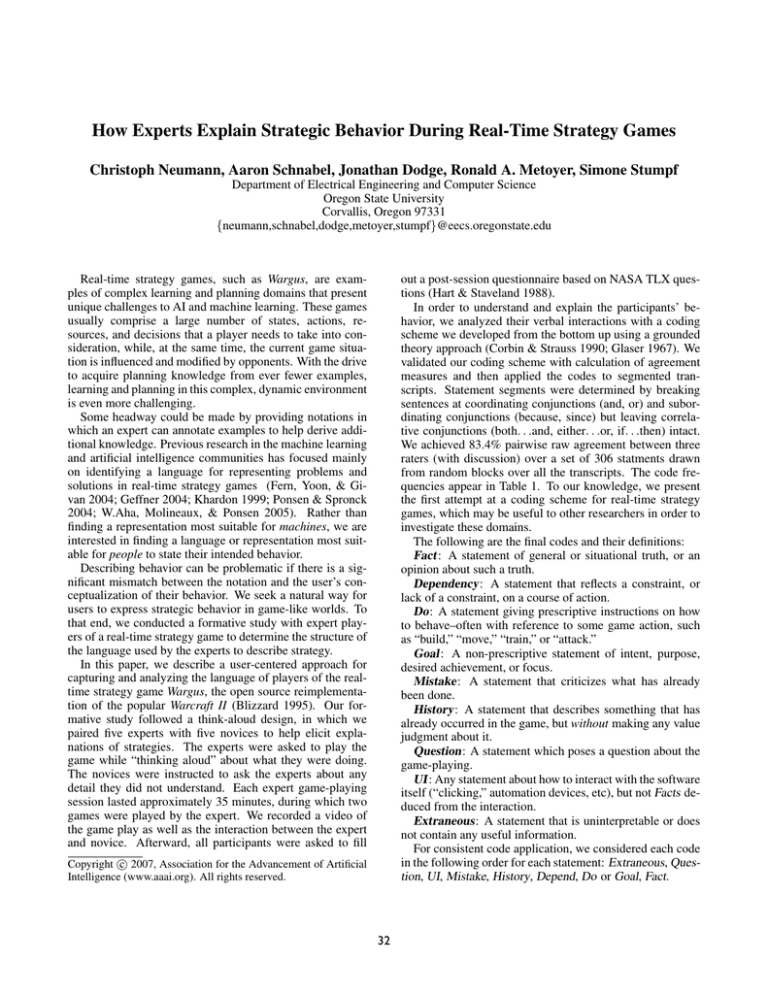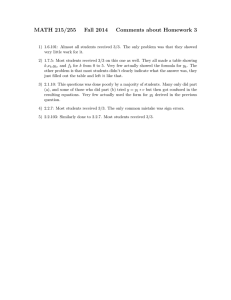
How Experts Explain Strategic Behavior During Real-Time Strategy Games
Christoph Neumann, Aaron Schnabel, Jonathan Dodge, Ronald A. Metoyer, Simone Stumpf
Department of Electrical Engineering and Computer Science
Oregon State University
Corvallis, Oregon 97331
{neumann,schnabel,dodge,metoyer,stumpf}@eecs.oregonstate.edu
out a post-session questionnaire based on NASA TLX questions (Hart & Staveland 1988).
In order to understand and explain the participants’ behavior, we analyzed their verbal interactions with a coding
scheme we developed from the bottom up using a grounded
theory approach (Corbin & Strauss 1990; Glaser 1967). We
validated our coding scheme with calculation of agreement
measures and then applied the codes to segmented transcripts. Statement segments were determined by breaking
sentences at coordinating conjunctions (and, or) and subordinating conjunctions (because, since) but leaving correlative conjunctions (both. . .and, either. . .or, if. . .then) intact.
We achieved 83.4% pairwise raw agreement between three
raters (with discussion) over a set of 306 statments drawn
from random blocks over all the transcripts. The code frequencies appear in Table 1. To our knowledge, we present
the first attempt at a coding scheme for real-time strategy
games, which may be useful to other researchers in order to
investigate these domains.
The following are the final codes and their definitions:
Fact : A statement of general or situational truth, or an
opinion about such a truth.
Dependency: A statement that reflects a constraint, or
lack of a constraint, on a course of action.
Do: A statement giving prescriptive instructions on how
to behave–often with reference to some game action, such
as “build,” “move,” “train,” or “attack.”
Goal : A non-prescriptive statement of intent, purpose,
desired achievement, or focus.
Mistake: A statement that criticizes what has already
been done.
History: A statement that describes something that has
already occurred in the game, but without making any value
judgment about it.
Question: A statement which poses a question about the
game-playing.
UI : Any statement about how to interact with the software
itself (“clicking,” automation devices, etc), but not Facts deduced from the interaction.
Extraneous: A statement that is uninterpretable or does
not contain any useful information.
For consistent code application, we considered each code
in the following order for each statement: Extraneous, Question, UI, Mistake, History, Depend, Do or Goal, Fact.
Real-time strategy games, such as Wargus, are examples of complex learning and planning domains that present
unique challenges to AI and machine learning. These games
usually comprise a large number of states, actions, resources, and decisions that a player needs to take into consideration, while, at the same time, the current game situation is influenced and modified by opponents. With the drive
to acquire planning knowledge from ever fewer examples,
learning and planning in this complex, dynamic environment
is even more challenging.
Some headway could be made by providing notations in
which an expert can annotate examples to help derive additional knowledge. Previous research in the machine learning
and artificial intelligence communities has focused mainly
on identifying a language for representing problems and
solutions in real-time strategy games (Fern, Yoon, & Givan 2004; Geffner 2004; Khardon 1999; Ponsen & Spronck
2004; W.Aha, Molineaux, & Ponsen 2005). Rather than
finding a representation most suitable for machines, we are
interested in finding a language or representation most suitable for people to state their intended behavior.
Describing behavior can be problematic if there is a significant mismatch between the notation and the user’s conceptualization of their behavior. We seek a natural way for
users to express strategic behavior in game-like worlds. To
that end, we conducted a formative study with expert players of a real-time strategy game to determine the structure of
the language used by the experts to describe strategy.
In this paper, we describe a user-centered approach for
capturing and analyzing the language of players of the realtime strategy game Wargus, the open source reimplementation of the popular Warcraft II (Blizzard 1995). Our formative study followed a think-aloud design, in which we
paired five experts with five novices to help elicit explanations of strategies. The experts were asked to play the
game while “thinking aloud” about what they were doing.
The novices were instructed to ask the experts about any
detail they did not understand. Each expert game-playing
session lasted approximately 35 minutes, during which two
games were played by the expert. We recorded a video of
the game play as well as the interaction between the expert
and novice. Afterward, all participants were asked to fill
c 2007, Association for the Advancement of Artificial
Copyright Intelligence (www.aaai.org). All rights reserved.
32
Table 1: Code frequency over the full set of transcripts (as a percent.)
Fact Depend Do Goal History Mistake Question UI
Code Frequency 33.2
12.0
12.1
7.9
7.6
1.9
9.2
7.4
Strategies are high-level plans that a user follows in order
to win the game. Strategies constrain and motivate the way
a player sequences actions in the game and manipulates the
game elements. Goals were a high-level way experts could
express strategy, but to our surprise, only 7.9% of all statements were Goals. However, 12.1% of statements were Do
statements. It appears that experts preferred to explain their
strategy by using a finer granularity, in which they made detailed reference to what to do in the context of the game.
Do and Goal appear to represent a spectrum of detail in
which to explain strategy, that, when combined, make up
20.0 ± 2.5% of statements regardless of transcript. However, experts exhibited a preference for choosing a certain
level of granularity in which to express the strategy. Experts
that chose high-level strategy explanations tended to provide
fewer detailed, fine-grained statements, and vice versa.
A reasonable but naive assumption would be that plans
and strategies are stated at the beginning and then enacted in
the remainder of a game. In our study, strategy explanations
(Do or Goal statements) were found interspersed throughout
both games–even for the second game in a session, in which
participants could have omitted strategy explanations since
they had already been covered previously.
Facts and Depends are found constantly throughout all
games in all transcripts and comprise a total of 45.2% of all
statements. Facts appear to draw attention to certain things
in the game that are important and matter. Depends appear to draw out constraints that need to be met. Therefore,
Facts and Depends provide the constraining context information in which strategies are enacted. Furthermore, continual modification and clarification of the context appears
to be needed throughout the entire game.
Questions provide an explicit indication that an insufficient explanation was provided and more details are needed.
Thus, we paid particular attention to questions that novices
asked experts, since they indicate a gap in the novice’s understanding. Similar frequencies (8.3%-13.0%) of Questions were recorded after every code, indicating gaps in all
kinds of information, except Do prompted frequent questions (20.3%) and Mistake prompted very few (3.3%.) So,
it appears that Do’s tended to require more detail.
Interestingly, when asked for more detail, experts did not
provide answers in terms of strategy–Goal and Do answers
were infrequent (1.9% and 6.5% respectively.) In contrast,
44.9% of statements that followed Questions were Facts and
13.1% were Depends. As discussed previously, Facts and
Depends explain the context in which the strategy is situated. It appears that answers often focused on the applicability and constraints to consider when applying the strategy.
Mistake statements were infrequent (1.9%) and tended to
appear when the expert was losing. 7.6% of statements were
History statements, but 43.2% of all History codes are concentrated right after a game. Within the game, History state-
Extran
8.5
ments seemed to draw out important aspects of the situation
that needed to be attended to at the time–sometimes this was
related to a mistake, but sometimes as part of a rationalization for the present course of action.
Conclusion
In designing an annotation language for strategy, one should
consider the following. Experts exhibited preference for different levels of granularity in their explanations. Furthermore, experts typically did not state strategy explicitly, but
provided it through a significant amount of prescriptive and
intentional explanations throughout the game. Within the
context of a game, experts tend to prefer to state what to do
in concrete game terms rather than high level terms. Additionally, experts used statements of fact and dependency
to provide an applicable and constraining context for their
explanations. Finally, experts require a means for pointing
out substantiation or errors of strategy or action already expressed or demonstrated.
References
Blizzard. 1995. Warcraft II:Tides of Darkness. Blizzard
Entertainment. http://www.battle.net/war2/, Last accessed
March 2007.
Corbin, J., and Strauss, A. 1990. Grounded theory research: Procedures, canons, and evaluative criteria. Qualitative Sociology 13(1):3–21.
Fern, A.; Yoon, S.; and Givan, R. 2004. Approximate
policy iteration with a policy language bias. Advances in
Neural Information Processing Systems 16(3):847–854.
Geffner, H. 2004. Planning graphs and knowledge compilation. In Proceedings of the Fourteenth International Conference on Automated Planning and Scheduling (ICAPS
2004).
Glaser, B. 1967. The Discovery of Grounded Theory:
Strategies for Qualitative Research. Aldine de Gruyter.
Hart, S. G., and Staveland, L. E. 1988. Development of
a multi-dimensional workload rating scale: Results of empirical and theoretical research. In Hancock, P. A., and
Meshkati, N., eds., Human mental workload. Amsterdam,
The Netherlands: Elsevier. 139–183.
Khardon, R. 1999. Learning action strategies for planning
domains. Artificial Intelligence 113(1-2):125–148.
Ponsen, M., and Spronck, P. 2004. Improving adaptive
game ai with evolutionary learning. Master’s thesis, Delft
University of Technology.
W.Aha, D.; Molineaux, M.; and Ponsen, M. 2005. Learning to win: Case-based plan selection in a real-time strategy game. Case-Based Reasoning Research and Development 5–20.
33









